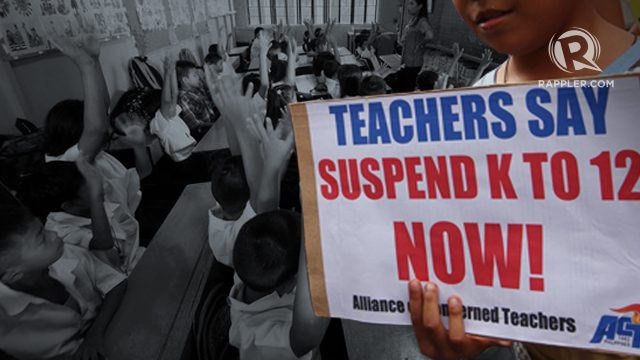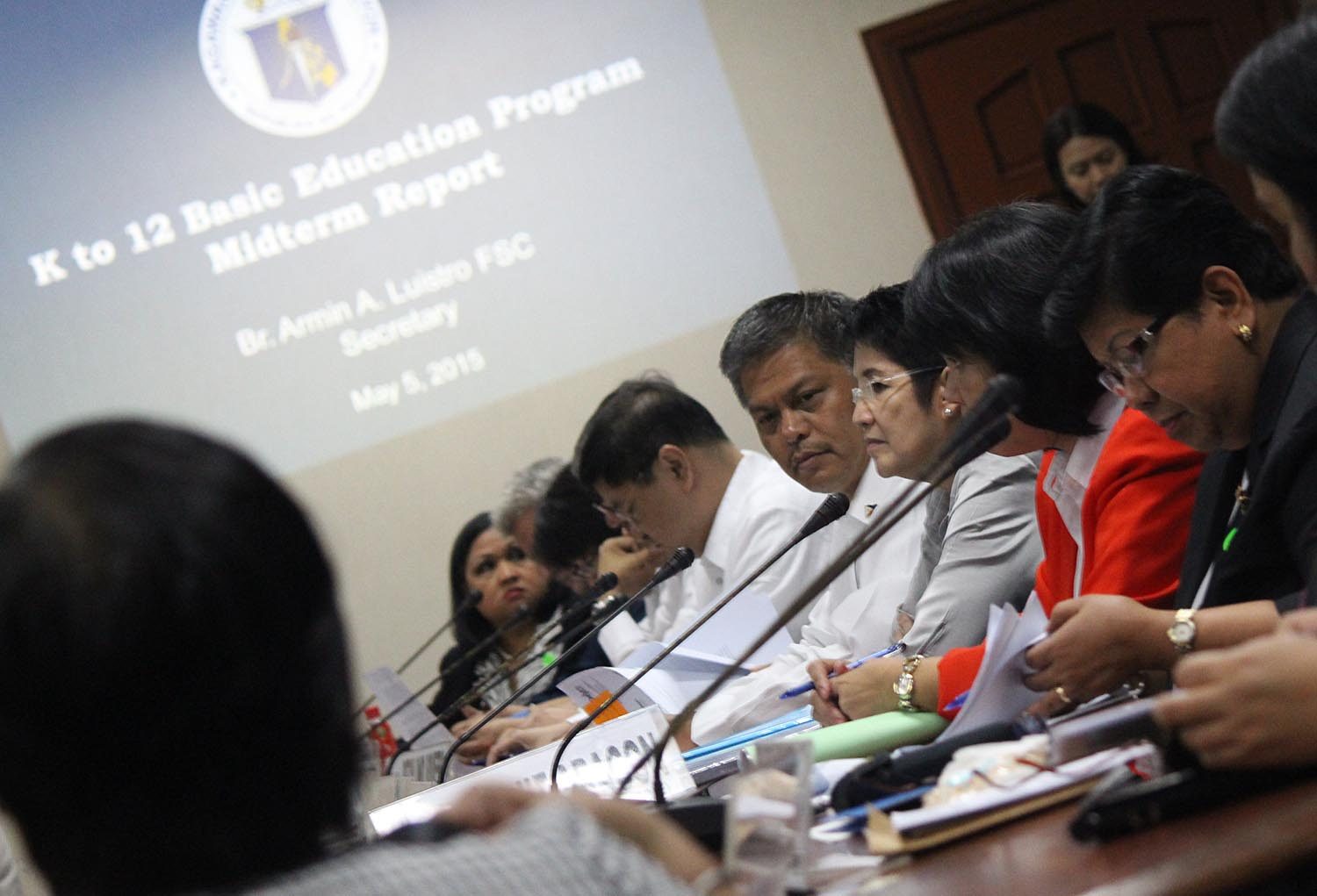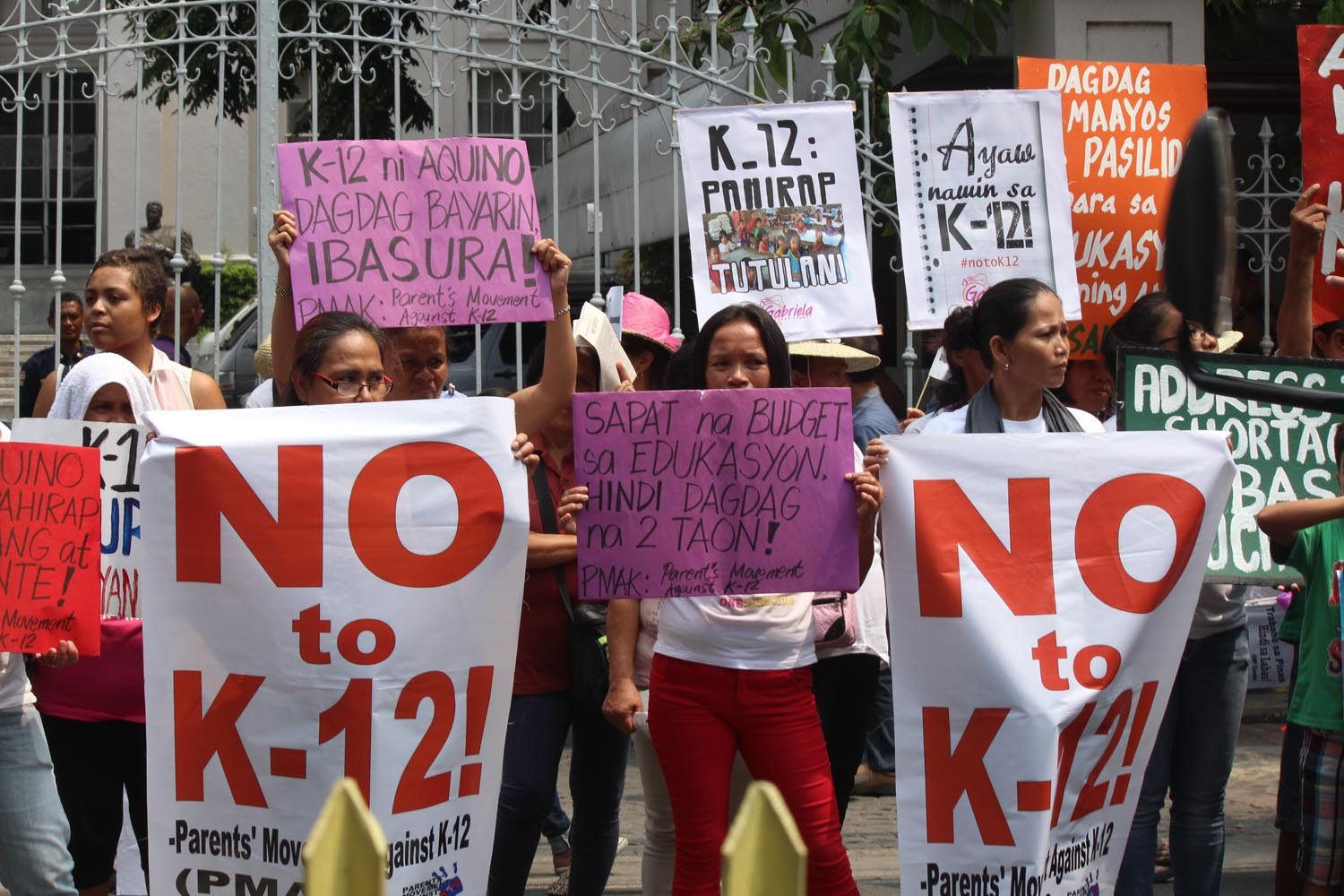SUMMARY
This is AI generated summarization, which may have errors. For context, always refer to the full article.

MANILA, Philippines – President Benigno Aquino III floated the idea of reforming the basic education cycle of the country from 10 years to 12 years in his first State of the Nation Address in 2010.
Three years later, he signed into law the Enhanced Basic Education Act of 2013, lauding the measure as one that will empower generations to contribute to the growth of Philippine society and economy.
While the bill did not go unopposed in both houses of Congress, the voice of dissent against the K to 12, as a law, grew louder in 2015 – a year before the program’s full implementation.
As 2016 drew closer, the challenges became more apparent. Thousands of college workers are likely to lose their jobs, and enrollment in colleges and universities is expected to drop in the next 6 years.
The education department vows to prioritize college workers in its hiring needs for the senior high school program. The Commission on Higher Education has allotted billions in its 2016 budget to help colleges and their faculty and staff during the K to 12 transition period.
But critics are not convinced. Since March 2015, at least 5 petitions have been filed before the Supreme Court, asking for the suspension of the K to 12 program.
Yet Education Secretary Armin Luistro doesn’t consider 2015 as the toughest year for the program. In fact, he doesn’t even think that K to 12 is as controversial as the media makes it appear to be.

“Anyone who suspends the K to 12, I will ask them to respond to global commitments. [I will] ask the hard question: So where do you want Filipino graduates to go?”
– Education Secretary Armin Luistro
If there’s public anxiety due to K to 12, the education secretary says it’s not mainly because of the petitions lodged with the SC. People are worried about the sustainability of the program, considering that there will be a change in administration by 2016 – the same year K to 12’s senior high school (SHS) will be implemented nationwide.
Asked what mechanisms are in place to assure Filipinos, he points back to the law itself and the investments that have gone into the program since it was implemented on the ground.
“I think there’s a lot more excitement than anxiety at this stage,” he told Rappler. In fact, he believes the program is now “over the hump” since most of the curriculum is already in place.
And he’s thrilled with the numbers too: at least 1.1 million Grade 10 students and 17,000 graduates from the 10-year cycle pre-registered for SHS. The number of Grade 10 students is close to their estimate of 1.2 million.
As for teachers, 41,000 applicants expressed their intent to teach in SHS – over and above the hiring needs of DepEd for 2016.
“The acceptability – at least when you think with the numbers that we have now in early registration – tell me that [students are] not just ready, they are willing, and they actually have enrolled,” he said.
DepEd’s internal study, he said, shows that orientation sessions in schools remain as the parents’ main source of K to 12 awareness – not media, nor word of mouth.
“Even media will have a difficulty explaining a full-blown reform – and this is educational reform – in soundbytes…. In marketing, to be able to communicate something new, studies say you have to repeat it 17 times…. I think we’re on our 6th year, so, we need about 11 more years,” Luistro joked.
While he’s not dismissing the program’s critics, he also insists that it’s K to 12’s “early fruits” that will convince people about it, like children picking up their books and reading more because they learned in the mother tongue in their early years.
For him, suspending the program will only cause chaos and will throw investments – both from government and the private sector – down the drain.
“When you’re on overdrive, how do you tell someone, ‘Step on the breaks, now!’ You’d go into a major accident,” he said.
Besides, Luistro says the Philippines, together with other nations, had committed to 12 years of “free, publicly funded, equitable quality primary and secondary education” with the Incheon Declaration.
The same declaration reads that at least 9 years of the 12 should be compulsory.
“Anyone who suspends the K to 12, I will ask them to respond to these global commitments and ask that question, the hard question: So where do you want Filipino graduates to go?” Luistro challenges critics.
“Talk to the world. This is not a choice for us. It is a global standard, and we’re at the last leg.”
But to answer the secretary’s question, at least two of the 5 petitioners asking for the suspension of the K to 12 want graduates to be able go to college in 2016, if they want to. They believe many parents and children think the same.

“Buong mundo nga nag-K to 12 na, hindi naman naging better place ang mundo, so ibig sabihin hindi lang education system ang may problema.”
– David Michael San Juan, Suspend K to 12 Alliance
David Michael San Juan of the Suspend K to 12 Alliance says if the High Court grants the suspension, there’s no need to go back to the old 10-year curriculum.
He believes there’s a way to work around the new curriculum that the education department started gradually implementing in 2012, or a year before the K to 12 was enacted.
“‘Yung K to 10, andyan na ‘yan, ayusin na natin, fine-tune na lang. Pero ‘yung mas drastic na pagbabago, magdadagdag ka ng two years na ‘di ka prepared, maraming maaapektuhan. ‘Wag muna, ‘di pa natin naaayos ‘yung K to 10 eh, sayang ‘yung pera, dun na lang gamitin. Wala pang mag-aaway-away,” he told Rappler.
(K to 10 is already there, so let’s just fine-tune it. But the more drastic change, adding two years when you’re not prepared, many will be affected. Let’s postpone that, because we haven’t fixed K to 10 yet. The investments will only go to waste. Let’s use it for K to 10 – we’ll even avoid conflicts that way.)
But Severo Brillantes, counsel for parents and teachers from the Manila Science High School (MSHS), disagrees with San Juan and says the old curriculum was “even better” than K to 12.
Brillantes represents another group of petitioners who want not just a suspension but a nullification of the law, because they allege that it “in effect diluted” their school’s special science curriculum. He says the new curriculum is a “huge step backward in so far as the development of science and technology is concerned.”
San Juan also believes the law should be junked because “we don’t need this education system.”
“Buong mundo nga nag-K to 12 na, hindi naman naging better place ang mundo, so ibig sabihin hindi lang education system ang may problema,” he said. (The entire world has already shifted to K to 12, but it has not become a better place, which means the education system is not the only problem.)
What issues have been raised vs K to 12?
- No consultation with “people most affected by the program” happened
- Thousands of workers will be displaced from colleges and universities
- A proposed transition fund does not appease worries of college workers
- Training of teachers started late in some schools
- Families’ additional expenses can reach up to P20,000
- Dropout rates will soar
- Voucher program shows public education system not capable of implementing K to 12
- SHS will be offered in hundreds of schools with no access to electricity or water supply
- The Filipino curriculum in K to 12 was not studied carefully
- Spending 80 hours on disaster risk is ‘not justified’
- Millions of new DepEd textbooks are not K to 12-aligned
Besides, with what they’re hearing from the ground, San Juan says, many Filipinos are for the suspension of the K to 12 – contrary to what the education secretary asserts.
“‘Pag tiningnan mo, from all colors of the political spectrum itong mga nag-file na grupo – from Trillanes to Makabayan bloc, from kanan to kaliwa ay nandiyan, mga conservative na unions, grupo nandiyan, mga teachers na ngayon lang nag-rally nandiyan,” he explained.
(If you look at it, the groups that filed the petitions come from all colors of the political spectrum – from Trillanes to Makabayan bloc, from right to left, conservative unions and groups are there, teachers who are only rallying now are there.)
He predicts chaos, too, if senior high school pushes through in 2016, worried that their worst fears may be realized: many students dropping out of high school and massive displacement of college workers, to name a few.
For Brillantes, whose son also belongs to the batch that will enter senior high school in 2016, a dismissal of their petition means he will have no choice but to send his child to Grade 11 – even if both father and son do not want “this additional burden.”
But their fight won’t end even if their petitions get dismissed. San Juan says they will continue going around the country to conduct forums and participate in rallies to convince more people to oppose the program.
A new president is coming in too by 2016, and what if he finds K to 12 problematic?
Both San Juan and Brillantes are hoping the next leader of the land will abandon the program which Aquino, in San Juan’s words, “rushed and railroaded” into enactment.
“Battle lines have been drawn…. More people should protest. This is a time [for] people to really speak out because we believe we can tilt the balance in our favor if more people show up and condemn this anti-democratic and despotic education curriculum,” Brillantes said.
Will the Supreme Court suspend K to 12, or will the petitions be dismissed?
The petitioners believe their facts are undisputed, while the education department, or at least their leader, is not anxious at all. Parents and their children have a few month’s window in the school calendar to know. – Rappler.com
Add a comment
How does this make you feel?
There are no comments yet. Add your comment to start the conversation.